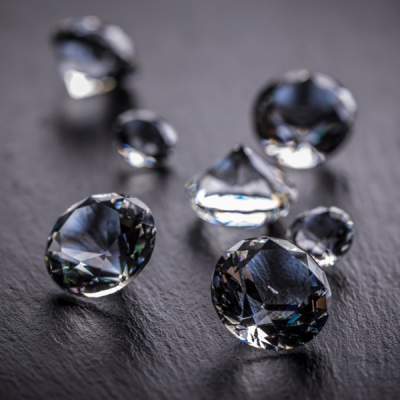Types Of Diamonds
When buying a diamond, most people immediately think of the 4Cs: Cut, Color, Clarity, and Carat. While the 4Cs are important, it's also important to decide what type of diamond you’d like to buy – mined (natural), treated, natural fancy colored, or lab-grown.
Understanding the 4Cs Of Diamonds
If you’re set on buying a classic diamond engagement ring, it’s important to learn the 4Cs: Cut, Color, Clarity, and Carat. Diamond Cut describes how the diamond has been polished and shaped. Color describes how colorless a diamond is, except when the diamond is a fancy color. Clarity describes how many inclusions or small imperfections. Carat is the measurement of the physical weight of a diamond. These factors determine the diamond’s quality. Becoming familiar with the 4Cs is ideal when buying a quality diamond. Understanding how the 4Cs affect the price and their relative importance is essential when getting the best diamond for your budget.
Different Types Of Diamonds
Natural Diamonds
One of the natural world’s rarest and most beautiful resources are natural diamonds found about 100 miles underneath the earth’s surface and must be mined to obtain. According to the Gemological Institute of America (GIA), natural diamonds are 58 times harder than any other naturally occurring substance. Diamonds are the only gem made exclusively from carbon, and were formed more than a billion years ago under a high temperature and pressure environment.
Considering these facts, it’s no wonder that natural diamonds are arguably the most highly prized gem globally.
Because natural diamonds are just that - natural - they rarely look as flawless as man-made diamonds. Nevertheless, these tiny imperfections make these gems all the more unique. Natural diamonds are also a great investment, as these precious stones have been traded for hundreds of years and continue to appreciate in value.
Treated Diamonds
Treated diamonds are natural in origin, but have undergone an altering process to enhance certain attributes of the diamond for appearance and quality’s sake. GIA notes that a very small percentage of gem-quality diamonds are treated, but when they are, diamonds are usually treated to enhance either their clarity or their color. Treatments like laser drilling and fracture filling can enhance clarity, while coating, irradiation, or High-Pressure High Temperature (HPHT) treatments can change a diamond’s color.
Buying a treated diamond may allow you to invest in a diamond with a more attractive appearance at a lower price. According to GIA, while this is a great benefit, beware that some treatments aren’t permanent. Coatings, for example, are a durable color treatment, but won’t last forever.
Diamond retailers are required to tell you if a diamond has been treated, but always ask about the treatment and grade to be sure.
Lab Grown Diamonds
Lab Grown Diamonds are “real” in essence. GIA explains that they have the same chemical construction, crystal structure, and physical properties as natural diamonds. While they’re essentially “real” diamonds because of these shared qualities, man-made diamonds aren’t identical to natural diamonds.
So, how do natural diamonds differ from lab grown ones? While natural diamonds need specific heat and pressure conditions deep under the earth to form over a long period of time, most lab grown diamonds are created in a controlled lab environment in just a few weeks. GIA identifies 2 different lab methods for creating lab grown diamonds: High Pressure High Temperature (HPHT) methods, or Chemical Vapor Deposition (CVD) methods.
Lab Grown diamonds can still have small inclusions and imperfect clarity grades, but because of their highly controlled environment, it’s easier to create a nearly flawless lab-grown diamond than it is to find a natural one.
The biggest difference between natural and lab grown diamonds is how they came to be. While natural diamonds spend billions of years underground before emerging as a precious sparkling jewel, lab grown diamonds spend mere weeks in a lab under carefully controlled conditions. These differing origin stories mean that you can buy a high-quality lab grown diamond for a lot less than a natural diamond sharing the same quality. If you’re trying to save money and origin doesn’t make a significant difference to you, a lab-grown diamond is a great choice.
Natural Fancy Color Diamonds
Natural fancy color diamonds are created the same way as natural diamonds. They are available in a vast array of colors. Most fancy-colored diamonds are a deep yellow or brownish color, but the rarest and most precious fancy-colored diamonds come in shades of blue, green, pink, and red.
While typical natural diamonds use the D-Z color scale to determine their lack of color, fancy colored diamonds’ worth increases when their color is vibrant and deep. Natural fancy colored diamonds are a great choice if you want to invest in an entirely unique, less conventional diamond.
Ready To Craft Your Perfect Diamond Ring—David Alan Can Help
Whether your diamond is natural, treated, fancy colored, or lab grown, choosing a reputable jeweler to craft your diamond ring is incredibly important. A high-quality ring starts with an expert jeweler who is truly invested in their creative process. Master jeweler and diamantaire, David Alan sits with his clients to discuss design, diamond preferences, timeline and budget to ensure you get rings that will last a lifetime and become your family heirloom.
Discover Custom, not Customary Fine Jewelry, Designed and Expertly Crafted for you
David Alan is a New York City based fine jewelry atelier with an incredible reputation for capturing and translating your raw emotion and passion into a beautifully balanced, and distinctly unique design. Every part of your David Alan experience contributes to a jewel so personal, it becomes your signature, your talisman, and your future heirloom. Start your journey now.
Engage in a complimentary virtual consultation with David Alan, today!


